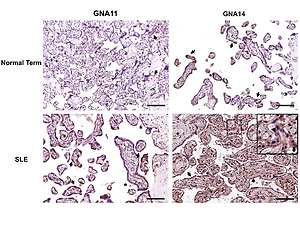Current issue
Archive
Manuscripts accepted
About the Journal
Editorial office
Editorial board
Section Editors
Abstracting and indexing
Subscription
Contact
Ethical standards and procedures
Most read articles
Instructions for authors
Article Processing Charge (APC)
Regulations of paying article processing charge (APC)
RESEARCH PAPER
G-protein subunit α-14 is dysregulated in human placentas from systemic lupus erythematosus pregnancies
1
Department of Rheumatology, Qilu Hospital, Cheeloo College of Medicine, Shandong University, Jinan, Shandong, China
2
Shandong Key Laboratory of Medicine and Prevention Integration in Rheumatism
and Immunity Disease, Jinan, Shandong, China
3
Center for Reproductive Medicine, Jinan Central Hospital, Jinan, Shandong, China
4
School for Radiological and Interdisciplinary Sciences, Soochow University, Suzhou, Jiangsu, China
5
Department of Obstetrics and Gynecology, School of Medicine and Public Health, University of Wisconsin-Madison, Madison, WI, USA
6
Clinical and Translational Research Center, Shanghai First Maternity and Infant Hospital, Tongji University School of Medicine, Shanghai, China
7
Department of Obstetrics and Gynecology, Qilu Hospital, Cheeloo College of Medicine, Shandong University, Jinan, Shandong, China
Submission date: 2021-09-14
Final revision date: 2022-01-24
Acceptance date: 2022-02-03
Online publication date: 2022-02-18
Corresponding author
Huihui Li
Department of Obstetrics and Gynecology, Qilu Hospital, Cheeloo College of Medicine, Shandong University, Jinan 250012, Shandong, China
Department of Obstetrics and Gynecology, Qilu Hospital, Cheeloo College of Medicine, Shandong University, Jinan 250012, Shandong, China
KEYWORDS
TOPICS
ABSTRACT
Introduction:
Systemic lupus erythematosus (SLE) is associated with placental dysfunctions during pregnancy, which may cause multiple adverse fetal and maternal outcomes. G-protein subunits -11 (GNA11) and -14 (GNA14) participate actively in angiogenesis via the modulation of endothelial function. This study aimed to determine whether GNA11 and GNA14 levels in placental tissues differed between SLE and normal term pregnancies.
Material and methods:
Twenty-four individuals, including 14 patients with SLE and 10 normal pregnant women, were included in this study. The expression levels of GNA11 and GNA14 in the placentas were examined using reverse transcription-quantitative polymerase chain reaction (RT-qPCR) and Western blotting analyses. The localization of GNA11 and GNA14 in placental tissues was evaluated using immunohistochemistry. The correlations between relative mRNA and protein expression levels of GNA11,14 and the Systemic Lupus Erythematosus Disease Activity Index (SLEDAI) scores were also analyzed.
Results:
RT-qPCR revealed that the mRNA levels of GNA14, but not GNA11, were significantly decreased by 50% (p = 0.01) in SLE vs. normal term placentas. Western blotting showed that the protein levels of GNA14, but not GNA11, were significantly increased by 3.52-fold (p = 0.02) in SLE vs. normal term placentas. In immunohistochemistry, positive staining for GNA11 and GNA14 was observed in trophoblasts and villous stromal cells of the placental tissues. The expression levels of GNA11 and GNA14 were not significantly correlated with the SLEDAI scores (r2 = 0.02~0.24, p = 0.08~0.75).
Conclusions:
The dysregulation of GNA14 in the placentas indicates a regulatory role during human SLE pregnancies.
Systemic lupus erythematosus (SLE) is associated with placental dysfunctions during pregnancy, which may cause multiple adverse fetal and maternal outcomes. G-protein subunits -11 (GNA11) and -14 (GNA14) participate actively in angiogenesis via the modulation of endothelial function. This study aimed to determine whether GNA11 and GNA14 levels in placental tissues differed between SLE and normal term pregnancies.
Material and methods:
Twenty-four individuals, including 14 patients with SLE and 10 normal pregnant women, were included in this study. The expression levels of GNA11 and GNA14 in the placentas were examined using reverse transcription-quantitative polymerase chain reaction (RT-qPCR) and Western blotting analyses. The localization of GNA11 and GNA14 in placental tissues was evaluated using immunohistochemistry. The correlations between relative mRNA and protein expression levels of GNA11,14 and the Systemic Lupus Erythematosus Disease Activity Index (SLEDAI) scores were also analyzed.
Results:
RT-qPCR revealed that the mRNA levels of GNA14, but not GNA11, were significantly decreased by 50% (p = 0.01) in SLE vs. normal term placentas. Western blotting showed that the protein levels of GNA14, but not GNA11, were significantly increased by 3.52-fold (p = 0.02) in SLE vs. normal term placentas. In immunohistochemistry, positive staining for GNA11 and GNA14 was observed in trophoblasts and villous stromal cells of the placental tissues. The expression levels of GNA11 and GNA14 were not significantly correlated with the SLEDAI scores (r2 = 0.02~0.24, p = 0.08~0.75).
Conclusions:
The dysregulation of GNA14 in the placentas indicates a regulatory role during human SLE pregnancies.
Share
RELATED ARTICLE
We process personal data collected when visiting the website. The function of obtaining information about users and their behavior is carried out by voluntarily entered information in forms and saving cookies in end devices. Data, including cookies, are used to provide services, improve the user experience and to analyze the traffic in accordance with the Privacy policy. Data are also collected and processed by Google Analytics tool (more).
You can change cookies settings in your browser. Restricted use of cookies in the browser configuration may affect some functionalities of the website.
You can change cookies settings in your browser. Restricted use of cookies in the browser configuration may affect some functionalities of the website.



